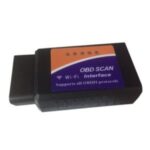The dreaded Check Engine Light illuminates your dashboard, and your OBD-II scanner reveals the cryptic code: P0101. What does it mean? This code indicates a problem with your vehicle’s Mass Airflow (MAF) sensor. This comprehensive guide will delve into the P0101 OBD-II trouble code, explaining its meaning, symptoms, causes, diagnostic procedures, solutions, and preventative measures. Understanding this code can empower you to address the issue effectively and keep your car running smoothly.
What Does the P0101 Code Mean?
The P0101 OBD-II trouble code signifies a problem within the Mass Airflow (MAF) sensor circuit. Specifically, the Engine Control Module (ECM), your car’s brain, detects an illogical or improbable voltage signal from the MAF sensor. This indicates that the sensor is not accurately measuring the amount of air entering the engine, crucial information for determining the correct air-fuel mixture.
Recognizing the Symptoms of a P0101 Code
A faulty MAF sensor can manifest in various driving issues. Common symptoms associated with the P0101 code include:
- Illuminated Check Engine Light: The most obvious sign.
- Poor Fuel Economy: Your car might consume more gas than usual.
- Reduced Engine Power: You may experience sluggish acceleration and decreased overall performance.
- Rough Idling: The engine may run unevenly or stall when idling.
- Hesitation or Stalling: The engine might hesitate or stall during acceleration.
- Black Smoke from Exhaust: A rich air-fuel mixture can cause black smoke.
Common Causes of a P0101 Code
Several factors can contribute to a malfunctioning MAF sensor and trigger the P0101 code. These include:
- Dirty or Contaminated MAF Sensor: Dirt, debris, or oil can hinder the sensor’s ability to measure airflow accurately.
- Faulty MAF Sensor: The sensor itself may be damaged or worn out.
- Vacuum Leaks: Leaks in the intake system can disrupt airflow readings.
- Damaged Wiring or Connectors: Frayed wires or loose connections can disrupt signal transmission.
- Intake Air Leaks: Unmetered air entering the engine after the MAF sensor can cause inaccurate readings.
Diagnosing a P0101 Code: Steps to Take
Diagnosing the root cause of a P0101 code requires a systematic approach:
- Visual Inspection: Check the MAF sensor for visible damage, dirt, or debris.
- Scan for Other Codes: Other codes may provide clues to related issues.
- Check Wiring and Connectors: Inspect for damage, looseness, or corrosion.
- Test MAF Sensor Voltage: Use a multimeter to verify the sensor’s voltage output.
- Inspect for Vacuum Leaks: Use a smoke machine or propane to detect leaks in the intake system.
- Check Air Filter: A clogged air filter can restrict airflow and impact MAF sensor readings.
Fixing a P0101 Code: Solutions and Repairs
Once the cause is identified, the appropriate solution can be implemented:
- Clean the MAF Sensor: Use a specialized MAF sensor cleaner to remove dirt and debris.
- Replace the MAF Sensor: If cleaning doesn’t resolve the issue, a new sensor is likely needed.
- Repair Vacuum Leaks: Seal any leaks found in the intake system.
- Repair or Replace Wiring and Connectors: Fix damaged wires or replace faulty connectors.
- Address Intake Air Leaks: Seal any leaks in the air intake system.
Preventing a P0101 Code: Proactive Maintenance
Preventative measures can help avoid future P0101 codes:
- Regularly Clean the MAF Sensor: Clean the sensor every 30,000 miles or as needed.
- Replace the Air Filter: Follow the manufacturer’s recommended replacement schedule.
- Inspect Vacuum Hoses and Connections: Regularly check for cracks, leaks, or loose connections.
Conclusion: Addressing the P0101 Code Head-On
The P0101 OBD-II trouble code, while potentially concerning, is often manageable with proper diagnosis and repair. By understanding the code’s meaning, recognizing its symptoms, and implementing the appropriate solutions, you can effectively address the issue and ensure your vehicle’s optimal performance and fuel efficiency. If you are unsure about any step in the diagnostic or repair process, consulting a qualified mechanic is always recommended.

